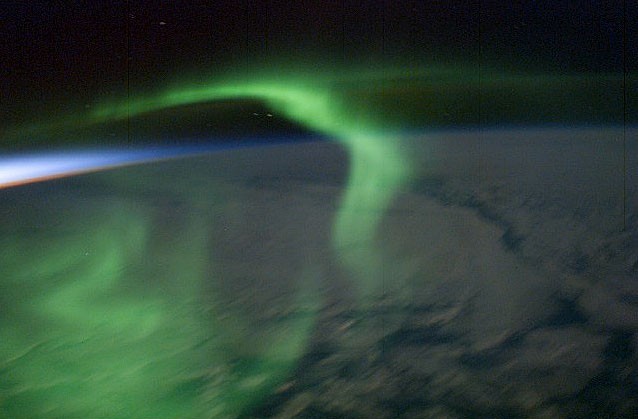
The northern polar region of Saturn shows both the aurora and underlying atmosphere, as captured by NASA's Cassini spacecraft

A green aurora dances over the night side of the Earth as seen from the
International Space Station in 2003. Earth, Jupiter and Saturn all have
dazzling auroras
 sciencetech Friday, Nov 14 2008
sciencetech Friday, Nov 14 2008
DM.has("lightBox");
Mysterious glowing aurora over Saturn confounds scientists
By
Daily Mail Reporter Last updated at 8:24 PM on 13th November 2008
A stunning light display over Saturn has stumped scientists who say
it behaves unlike any other planetary aurora known in our solar system.The blueish-green glow was found over the ringed planet's north polar region just like Earth's northern lights.It was discovered by the infrared instruments on NASA's Cassini spacecraft.
'We've never seen an aurora like this elsewhere,' said Tom Stallard,
a scientist working with Cassini data at the University of Leicester.'This
aurora covers an enormous area across the pole. Our current ideas on
what forms Saturn's aurora predict that this region should be empty, so
finding such a bright aurora here is a fantastic surprise.'
More...Auroras are caused by charged particles streaming along the magnetic field lines of a planet into its atmosphere.Particles from the sun cause Earth's auroras. Many, but not all, of the
auroras at Jupiter and Saturn are caused by particles trapped within
the magnetic environments of those planets.
Jupiter's main auroral ring is caused by interactions in Jupiter's
magnetic environment and remains constant in size. Saturn's main aurora
is caused by the solar wind, and changes size dramatically as the wind
varies. However, the newly observed aurora at Saturn doesn't fit into
either category.
The new infrared aurora appears in a region
hidden from NASA's Hubble Space Telescope. Cassini observed it when the
spacecraft flew near Saturn's polar region.
In infrared
light, the aurora sometimes fills the region from around 82 degrees
north all the way over the pole. This new aurora is also constantly
changing, even disappearing within a 45 minute-period. 'There is
something special and unforeseen about this planet's magnetosphere and
the way it interacts with the solar wind and the planet's atmosphere,'
Cassini scientist Nick Achilleos from the University College London
said.
The Cassini-Huygens mission is a cooperative project of NASA, the European Space Agency and the Italian Space Agency.
http://www.dailymail.co.uk/sciencetech/article-1085354/Mysterious-glowing-aurora-Saturn-confounds-scientists.html#